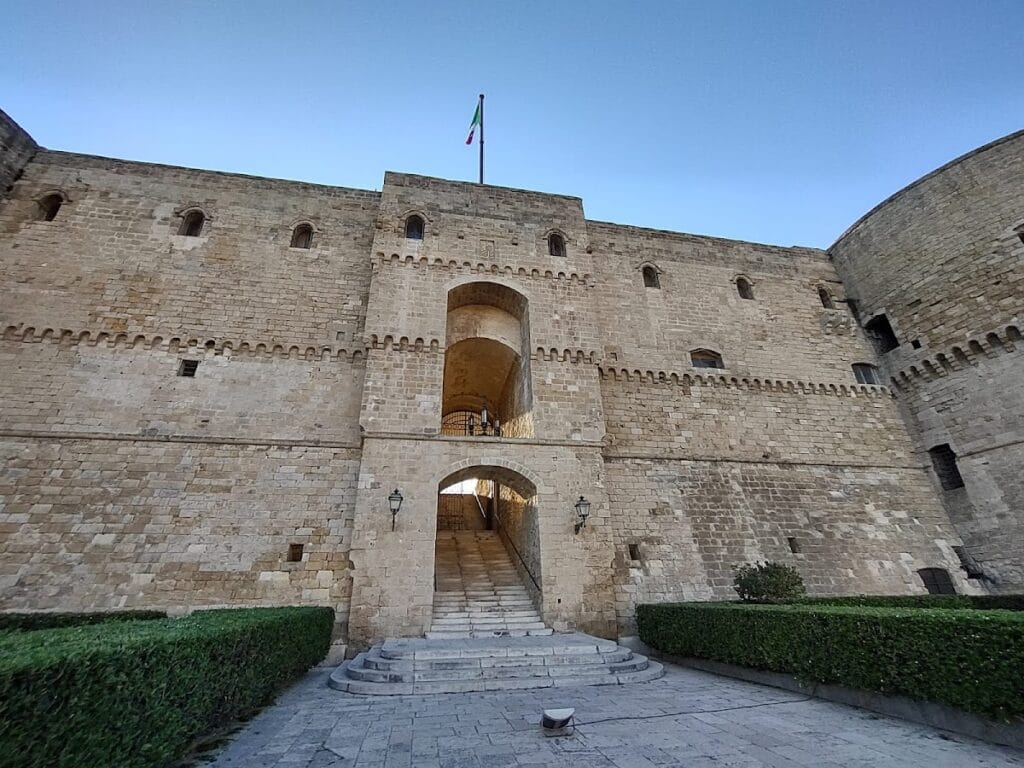Castello Aragonese, Taranto: A Historic Fortress in Southern Italy
Visitor Information
Google Rating: 4.7
Popularity: Medium
Google Maps: View on Google Maps
Official Website: www.castelloaragonesetaranto.com
Country: Italy
Civilization: Medieval European
Remains: Military
History
The Castello Aragonese, located in the city of Taranto in southern Italy, originated as a Byzantine fortress constructed in the early 10th century. Its initial purpose was to defend the coastal settlement against frequent Saracen raids and pressure from Venetian forces. The earliest fortifications featured tall, slender towers designed for active defense using traditional weapons such as lances, bows, stones, and boiling oil.
In the late 15th century, King Ferdinand I of Aragon commissioned a significant transformation of the site. Between 1486 and 1492, under the direction of architect Francesco di Giorgio Martini, the fortress was expanded and modernized to suit the emerging era of artillery warfare. This reconstruction replaced the older narrow towers with broader, lower circular bastions capable of mounting heavy cannons. The completion of this work was commemorated by a plaque above the Porta Paterna, displaying the Aragonese coat of arms and inscription dating to 1492.
Throughout the 16th and 17th centuries, during Spanish dominion over the region (1502 to the early 1700s), the fortress’s defenses were further strengthened. Efforts included widening the surrounding moat and adding a three-tower fortification to enhance protection. A municipal project led to the construction of an additional tower—the Torre Sant’Angelo—although this structure was demolished in the late 19th century to facilitate the building of a navigable canal and a swing bridge, reflecting changes in urban and maritime infrastructure.
Following the transfer of control to the Habsburg monarchy in 1707, the Castello Aragonese lost much of its strategic military importance. During this period, it served primarily as a prison until the Napoleonic era (1806–1815), when it temporarily resumed a defensive role. From 1887 onward, the castle became the headquarters for the Italian Navy in Taranto, marking a shift from fortress to administrative and military office functions. Restoration programs initiated in the early 20th century and extending into the early 21st century aimed to recover the castle’s appearance as it was in the late 15th century under Aragonese rule.
Archaeological investigations conducted in 2003 beneath the chapel crypt revealed ceramic fragments dating to the 13th and 14th centuries as well as a coin minted in 1245. These findings attest to continuous occupation and activity on the site long before the Renaissance modifications.
Remains
The Castello Aragonese forms a polygonal defensive complex situated on the Isola del Borgo Antico, a small island central to the old town of Taranto. The fortress’s southern core is nearly rectangular and anchored by four massive corner towers. These towers—known as Torrione S. Cristoforo, Torrione S. Lorenzo, Torrione della Bandiera, and Torrione dell’Annunziata—feature exceptionally thick exterior walls, measuring between seven and eight meters. Their substantial dimensions underscore the fortress’s late medieval adaptation for artillery defense.
These four main towers are interconnected by broad building wings, creating a large internal courtyard open to the sky. Projecting from the southern curtain wall that faces the open sea (Mar Grande) is a triangular defensive outwork called the Rivellino. This feature was designed to offer additional layers of protection by controlling approaches from the waterfront.
North of the central section lies a trapezoidal annex that once accommodated the now-demolished Torre Sant’Angelo. The fortress’s towers rise approximately 20 meters in both height and diameter, while curtain walls linking them extend roughly 40 meters in length. These walls were constructed to support four levels from which artillery could be fired, reflecting the advanced military techniques of the late 15th century.
Two drawbridges, which could be raised or lowered as needed, once provided controlled access across an artificial moat. The Ponte del Soccorso connected the castle to the Borgo district, a suburb associated with the newer part of town, while the Ponte dell’Avanzata linked the fortress across the moat to the Borgo Antico, the older town area. These defensive crossings allowed the castle to regulate entry and enhance security.
Inside the fortress stands the Saint Leonard Chapel, a space that has served various roles over time. Originally consecrated for religious use, it was later repurposed as a guardhouse and stable before its reconsecration in 1933. The chapel features the coat of arms of King Philip II of Spain and two carved Carparo stone slabs depicting a holy bishop and an armed medieval warrior. These carvings connect the chapel to both spiritual and military traditions associated with the castle.
Beneath the chapel floor, archaeological digs uncovered medieval ceramic shards and a coin dated 1245, linking the site’s religious structure to earlier historical periods. Another notable interior space is the castle’s torture chamber, which has a vaulted ceiling pierced by a central hole. This architectural detail was intended to amplify the cries of prisoners, serving as a psychological tool to intimidate and control.
Overall, the Castello Aragonese in Taranto preserves a multi-layered architectural record shaped by centuries of military, administrative, and religious use, showcasing the evolution of defensive technology from the early medieval period through the Renaissance and beyond.










